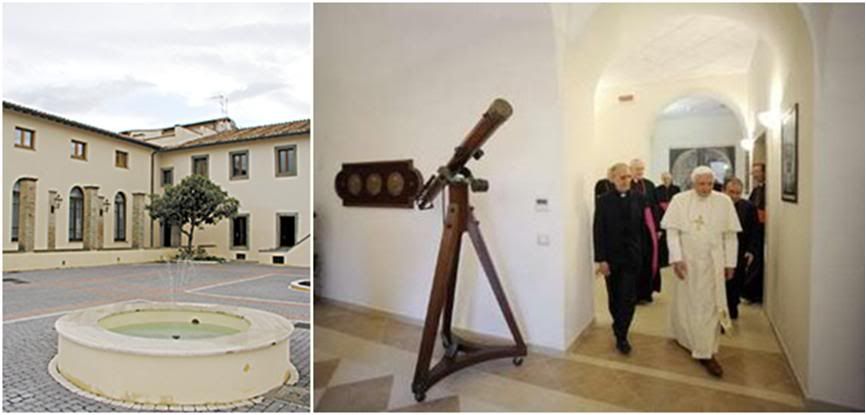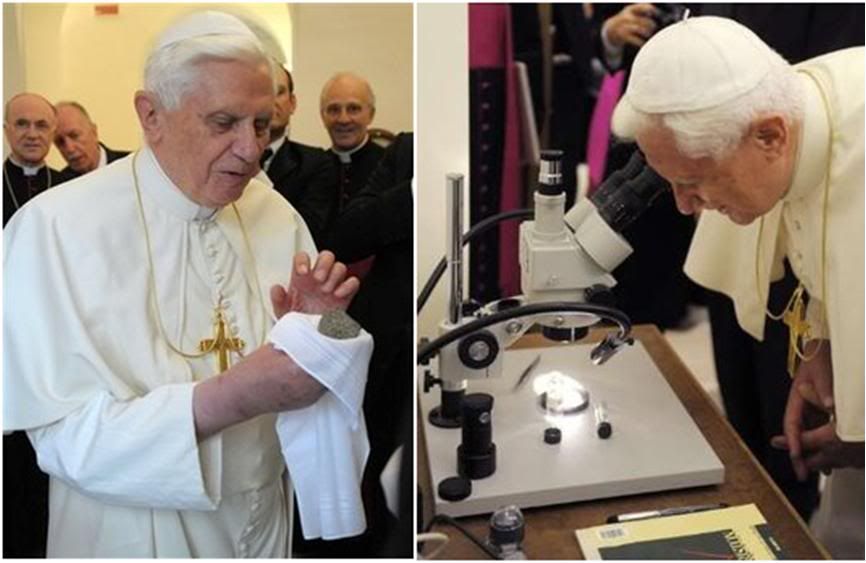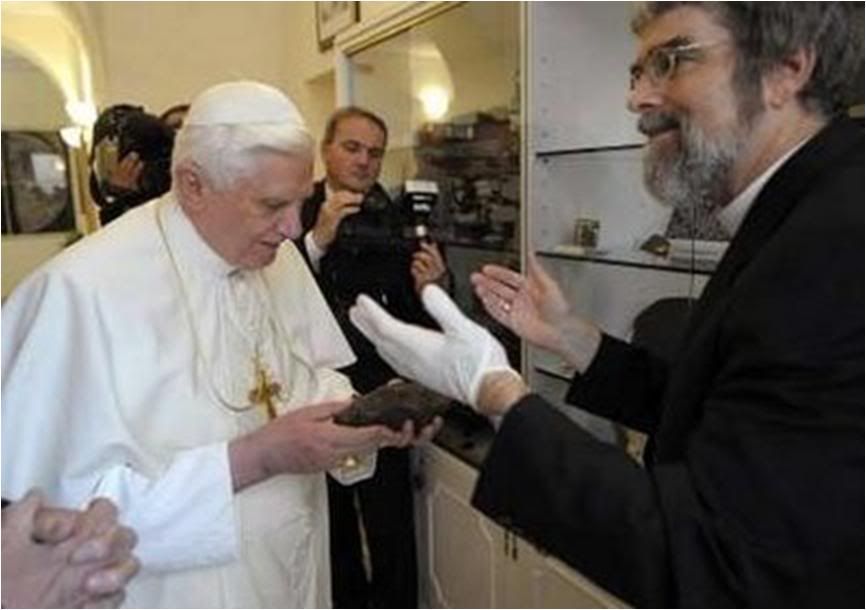
 Benedict XVI visits
Benedict XVI visits
new headquarters
of the Vatican Observatory
 The Observatory's webpage on the Vatican site is quite active and very informative, and is in both Italian and English. It is part of the observance of the 2009 International Year of Astronomy.
The Observatory's webpage on the Vatican site is quite active and very informative, and is in both Italian and English. It is part of the observance of the 2009 International Year of Astronomy.
Yesterday, Sept. 16, Pope Benedict XVI paid his first visit to the new headquarters of the Vatican Observatory which was housed for decades in the Apostolic Palace in Castel Gandolfo.
The new headquarters is situated within the grounds of the Pontifical Villas, at its northern boundary where it adjoins the town of Albano. In an interview with L'Osservatore Romano, Fr. Jose Funes, director of the Observatory, says that its two telescopes remain in the Apostolic Palace.
There is no accompanying story for the Pope's visit so far, only the ff photos released by the Vatican.


 In these photos, the Pope looks at the Observatory Museum's collection of meteorite fragments and other space artifacts, including a rock from Mars.
In these photos, the Pope looks at the Observatory Museum's collection of meteorite fragments and other space artifacts, including a rock from Mars.
P.S.
Here's the story on the above event from tomorrow's issue of L'Osservatore Romano.
At the blessing of the new Observatory offices:
A piece of Mars in the Pope's hands
by Gianluca Biccini
Translated from
the 9/18/09 issue of

It is not everyday that one can see the Pope holding a Martian rock in his hands, nor looking at a microscope to examine a fragment from a meteorite that fell to earth in his native Bavaria, although some of his predecessors may well have looked through some historic volumes written by Copernicus, Kepler and Newton.
[What, no Galileo????]
All this happened Wednesday afternoon, Sept. 16, in Castel Gandolfo, when Benedict XVI visited the new offices of the Vatican Observatory, a world-renowned astronomical institution.
The Observatory's Jesuit staff [the order has traditionally been in charge of the Observatory] moved here last June from the Apostolic Palace where the Observatory has been housed since 1935.
Their new home is a converted inactive monastery on the grounds of the pontifical estate in Castel Gandolfo. About two kilometers from the Apostolic Palace, it is found on the extreme south end of the estate, near the gate that opens into Piazza Pia in the historic center of adjoining Albano Laziale.
The Pope spent almost an hour visiting with the small scientific community in a vary familial atmosphere. He was accompanied by Archbishop James Harvey, prefect of the Apostolic Household; his two private secretaries, Monsignors Georg Gaenswein and Alfred Xuereb; and Saverio Petrillo, director of the Pontifical Villas in Castel Gandolfo.
They were welcomed by Cardinal Giovanni Lajolo and Archbishop Carlo Maria Vigano, president and secretary-general, respectively, of the Vatican Governatorate (of which the Observatory is a special department), and by the Jesuit superior general, Fr. Adolfo Nicolas, and the director of the Observatory, Fr. Jose Gabriel Funes.
The Pope first blessed the premises and led a brief moment of prayer. Cardinal Lajolo showed him a plaque that commemorates the visit.
Then he was shown around the offices, the meeting halls, the school area [the Observatory offers summer courses for astronomers as well as periodic lectures], the library, the staff residence, and finally, the museum.
After viewing the Museum's historical collection of astrolabes and telescopes, the Pope spent some time looking at their precious collection of meteorite evidence from which much information about the primordial solar system has been deduced.
An American astronomer, Fr. Guy Consolmagno, showed him some of the more interesting specimens, particularly a rock from the meteorite shower in the locality of Nakhla, Egypt, in 1911, determined to have come from the Red Planet.
The Pope was given the rock - on a clean cloth - to examine, as he asked them about its composition and how scientists had ascertained that the meteorite came from Mars.

He also touched a large rock taken from the huge meteorite that fell on Devil's Canyon in Arizona and produced the largest meteorite crater on earth. And he looked at a moon rock [NASA gave moon rocks acquired from various expeditions to registered observatories around the world].
Afterwards, the director of technical services for Vatican state, explained to him the reconstruction work that had been carried out on the old monastery. Part of the complex will house a residence for visiting scientists.

In the library, Fr. David Brown, an Oxford-trained astronomer, showed him historical editions of works which were seminal for astrophysics and cosmology:
De revolutionibus orbium coelestium by Copernicus,
Epitome astronomiae by Kepler and Newton's
Philosophiae naturalis principia mathematica.
The Pope also looked at the volume
Le stelle (The stars) by Fr. Angelo Secchi, who had pioneered the classification of stars according to their spectral characteristics. He said it brought him back to his years as a young priest in Munich
[No further explanation given by the reporter]. Did youhg Fr. Ratzinger dabble in astronomy then?
Shortly afterwards, he looked through a microscope at the 1768 meteorite fragment from Bavaria.
He then proceeded to the chapel of the Jesuits, whose local superior is Fr. Giuseppe Koch. He signed a parchment which will be displayed alongside those of similar parchments signed by his predecessors, among them Pius XI, who by a singular coincidence, had visited the Observatory 75 years earlier, on September 16, 1934.
Observatory director Fr. Funes also showed the Pope the book entitled
The heavens proclaim: Astronomy and the Vatican published this year by the Vatican publishing house.
The Vatican Observatory is one of the oldest in the world, originating in the second half of the 16th century, when Gregory XIII ordered the construction of the Torre dei Venti (Tower of the Winds) at the Vatican, inviting the Jesuit astronomers and mathematicians of the Collegio Romano to prepare the reforms that would lead to the Gregorian calendar in 1582.
The modern-day Observatory dates back to Leo XIII who issued a motu proprio
Ut mysticam on March 14, 1891, establishing an Observatory in the Vatican Gardens behind St. Peter's Basilica. The new headquarters is the fourth one for the Observatory since then.
Since 1981, the Observatory has maintained a major research site in cooperation with the University of Arizona's Stewart Observatory in Tucson. Vatican astronomers developed the first infrared telescope and mounted it on Mt. Graham in Arizona, considered the best astronomical observation point in North America.
The current version of the telescope is called VATT (for Vatican advanced technology telescope), one of three super-telescopes on the mountain. The two others belong to American observatories.
 Above, from left, VATT locator in the United States; a view of VATT; and two other super-telescopes on Mt. Graham. Below, from left, a general view of Mt. Graham; the Vatican book on astronomy; and a poster announcing the Vatican Observatory's summer school (VOSS) for 2010.
Above, from left, VATT locator in the United States; a view of VATT; and two other super-telescopes on Mt. Graham. Below, from left, a general view of Mt. Graham; the Vatican book on astronomy; and a poster announcing the Vatican Observatory's summer school (VOSS) for 2010.

The Observatory's activities are made possible through the Vatican Observatory Foundation headed by the immediate past director of the Observatory, Fr. George Coyne, who was also present Wednesday in Castel Gandolfo.
[Modificato da TERESA BENEDETTA 17/09/2009 21:34]